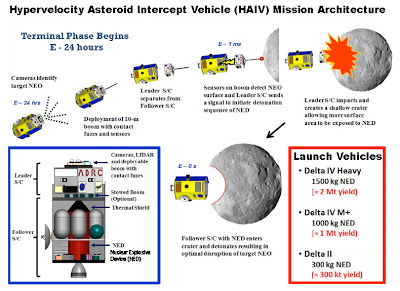This is a phase 2 NASA NIAC study.
A Hypervelocity Asteroid Intercept Vehicle (HAIV) mission architecture, which blends a hypervelocity kinetic impactor with a subsurface nuclear explosion for optimal fragmentation and dispersion of hazardous near-Earth objects (NEOs), has been developed through a 2011 NIAC Phase I study. Despite the uncertainties inherent to the nuclear disruption approach, disruption can become an effective strategy if most fragments disperse at speeds in excess of the escape velocity of an asteroid so that a very small number of fragments impacts the Earth. Thus, the proposed HAIV system will become essential for reliably mitigating the most probable impact threat: NEOs with warning times shorter than 10 years. It offers a potential breakthrough or great leap in mission capabilities for mitigating the impact threat of NEOs. The proposed Phase II study further develops the HAIV-based mission architecture and explores its potential infusion options within NASA and beyond.
Direct intercept missions with a short warning time will result in closing impact velocities of 10-30 km/s with respect to the target asteroid. Given such a large arrival velocity correction requirement, a last-minute rendezvous mission to the target asteroid is infeasible with existing launch vehicles. Furthermore, state-of-the-art penetrating subsurface nuclear explosion technology limits the penetrator’s impact velocity to less than approximately 300 m/s because higher impact velocities prematurely destroy the nuclear fuzing mechanisms. Consequently, hypervelocity nuclear interceptor/penetrator technology needs to be significantly advanced to enable a last-minute NEO disruption mission with intercept velocities as high as 30 km/s. The proposed HAIV system consists of a fore body (a leader spacecraft) to provide proper kinetic-energy impact crater conditions for an aft body (a follower spacecraft) carrying nuclear explosives. The proposed concept exploits the inherent effectiveness of a subsurface nuclear explosion for NEO disruption (fragmentation and dispersion). It is known that a generic 300-kt nuclear explosion at 3-m depth of burst has the ground-shock-coupling enhancement factor of at least 20, which is equivalent to a simpler contact burst of approximately 6-Mt. However, the proposed system’s complexity versus its benefits needs to be further investigated in the proposed Phase II study. Thus, the primary objective of Phase II study is to further assess various key issues such as performance robustness/sensitivity, mission reliability, system/mission complexity vs. benefits, development time and cost, and infusion path options of the proposed innovative solution to NASA’s NEO Impact Threat Mitigation Grand Challenge.
The goals of the Phase II study are to advance the HAIV technology from TRL 1-2 to TRL 3 and to identify key enabling technologies required for the HAIV system. A 10-year technology roadmap for NASA’s NEO Impact Threat Mitigation Grand Challenge as well as a near-term demo mission architecture for flight-validating planetary defense technologies (but without carrying actual nuclear explosives) will be developed in the Phase II study.
If you liked this article, please give it a quick review on ycombinator or StumbleUpon. Thanks

Brian Wang is a Futurist Thought Leader and a popular Science blogger with 1 million readers per month. His blog Nextbigfuture.com is ranked #1 Science News Blog. It covers many disruptive technology and trends including Space, Robotics, Artificial Intelligence, Medicine, Anti-aging Biotechnology, and Nanotechnology.
Known for identifying cutting edge technologies, he is currently a Co-Founder of a startup and fundraiser for high potential early-stage companies. He is the Head of Research for Allocations for deep technology investments and an Angel Investor at Space Angels.
A frequent speaker at corporations, he has been a TEDx speaker, a Singularity University speaker and guest at numerous interviews for radio and podcasts. He is open to public speaking and advising engagements.


